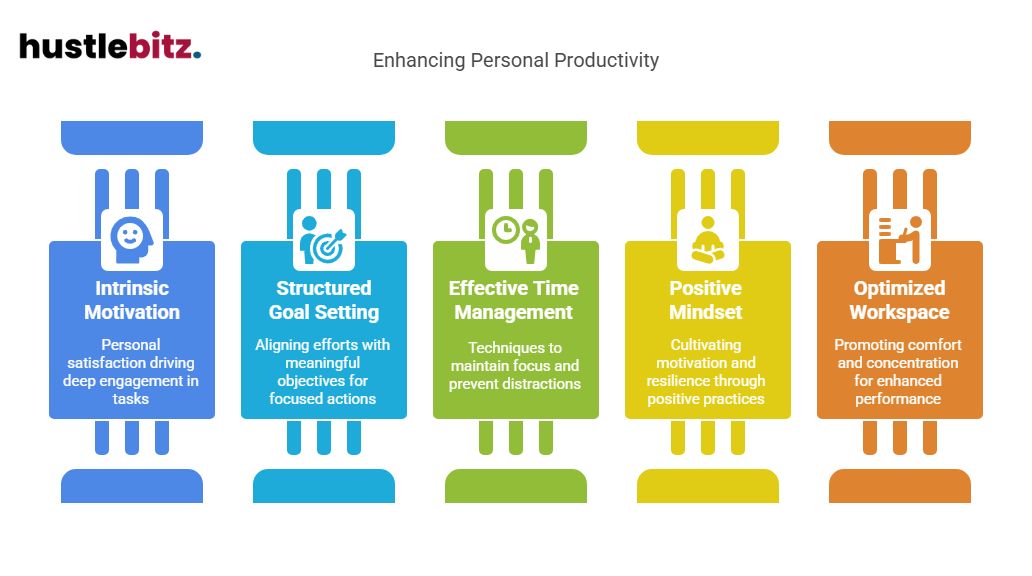Motivation and productivity are closely intertwined. An increase in motivation, whether intrinsic or extrinsic, can significantly enhance an individual’s efficiency and effectiveness in task completion. Motivated individuals typically set meaningful goals, which fosters satisfaction and a deeper commitment to their work. Additionally, a positive mindset encourages resilience, allowing individuals to view challenges as opportunities for growth. Effective time management and an optimal work environment further amplify this connection by enhancing focus and minimizing distractions. By cultivating motivation, individuals can transform their drive into measurable productivity gains, hinting at further techniques to optimize this relationship.
Key Takeaways
- Intrinsic motivation fosters personal satisfaction, driving individuals to engage deeply in tasks, which enhances overall productivity.
- Structured goal setting aligns efforts with meaningful objectives, leading to focused actions and improved outcomes.
- Effective time management techniques, like the Pomodoro Technique, help maintain focus and prevent distractions, boosting productivity.
- A positive mindset, cultivated through practices like gratitude journaling and mindfulness, enhances motivation and resilience in the face of challenges.
- An optimized workspace promotes emotional comfort and concentration, significantly influencing motivation levels and work performance.

Understanding Motivation

Understanding motivation is essential for enhancing productivity, as it drives individuals to pursue their goals with purpose and determination. Central to this understanding are motivation theories, notably intrinsic motivation and extrinsic rewards.
Intrinsic motivation refers to the internal desire to engage in activities for their own sake, while extrinsic rewards involve tangible benefits such as bonuses or recognition. Both forms of motivation play a crucial role in goal setting and achieving desired outcomes.
Self-Determination Theory (SDT) posits that fulfilling psychological needs—autonomy, competence, and relatedness—enhances intrinsic motivation, leading to more sustainable behavior change. By nurturing these needs, individuals can experience mindset shifts that foster greater engagement in their tasks.
Motivational interviewing serves as a practical tool in this context, encouraging individuals to explore their motivations and resolve ambivalence towards their goals. This approach fosters a collaborative environment where individuals can articulate their intrinsic rewards, making it easier to align their actions with their values.
Understanding the interplay between intrinsic and extrinsic motivations allows for more effective strategies in behavior change. For example, enhancing intrinsic motivation through meaningful goal setting can lead to increased satisfaction and productivity over time.
The Role of Productivity

Productivity serves as a critical measure of efficiency and effectiveness in both personal and professional contexts, directly influencing the achievement of goals and overall success.
By implementing structured goal setting, individuals can establish clear objectives that lead to focused efforts. Task prioritization is essential; it ensures that the most impactful activities are addressed first, optimizing the workflow and enhancing overall productivity.
To assess productivity effectively, performance metrics should be employed. These metrics provide quantifiable data that help in understanding progress and areas needing improvement. Utilizing accountability partners can further bolster this process, as they encourage commitment and provide external motivation to stay on track.
Distraction management is another vital aspect of enhancing productivity. By identifying and mitigating potential distractions, individuals can maintain higher energy levels and concentration, allowing for more efficient task completion.
Furthermore, engaging in personal development and skill enhancement activities can significantly contribute to increased productivity. As individuals improve their competencies, they can tackle complex tasks more effectively.
Feedback loops are crucial in this context, as they allow for continuous improvement by providing insights into what works and what doesn’t. Regular reflection on performance and adjusting strategies accordingly can lead to sustained productivity gains.
The Motivation-Productivity Connection

A strong link exists between motivation and productivity, as the drive to achieve goals directly influences an individual’s ability to perform effectively and efficiently. Understanding this connection involves exploring various factors, including intrinsic motivation, which fuels personal satisfaction, and extrinsic rewards that provide external validation. Goal setting plays a crucial role; clearly defined objectives can enhance focus and drive.
Developing self-discipline habits is essential for maintaining consistent effort, while motivation theories can offer insights into what drives individuals. For instance, having accountability partners can reinforce commitment to tasks, leveraging social support to overcome motivation challenges. Emotional intelligence also contributes to this connection, as it enables individuals to manage their feelings and understand others, fostering a collaborative work environment.
The following table outlines key components that illustrate the motivation-productivity connection:
| Component | Description |
| Intrinsic Motivation | Internal drive based on personal satisfaction |
| Extrinsic Rewards | External incentives that acknowledge achievements |
| Goal Setting | Establishing clear, measurable objectives |
| Self-Discipline Habits | Consistent behaviors that promote productivity |
| Positive Reinforcement | Rewarding positive behaviors to encourage repetition |
Visualization techniques can also enhance motivation by allowing individuals to envision their success. Together, these elements create a robust framework where motivation directly enhances productivity, enabling individuals to overcome challenges and achieve their goals.
Cultivating a Positive Mindset
Cultivating a positive mindset is essential for enhancing motivation and, subsequently, productivity in both personal and professional settings. A growth mindset encourages individuals to view challenges as opportunities for learning, fostering resilience and intrinsic motivation. Engaging in self-reflection practices allows individuals to assess their thoughts and behaviors, leading to a clearer understanding of personal goals and aspirations.
Incorporating gratitude journaling into daily routines can significantly shift focus from obstacles to opportunities, enhancing overall well-being. Positive affirmations serve as powerful tools that reinforce self-belief and encourage a proactive approach to challenges. Furthermore, developing emotional resilience equips individuals with the skills to navigate setbacks without losing momentum.
Visualization techniques can be instrumental in manifesting desired outcomes. By vividly imagining success, individuals can create a mental roadmap that aligns with their goals. Mindfulness meditation promotes presence and awareness, reducing stress and boosting cognitive function, which in turn nurtures a positive mindset.
Goal setting is another critical component, as it provides direction and purpose. When coupled with self-compassion strategies, individuals can be kinder to themselves during difficult times, ultimately fostering a more constructive internal dialogue.
This holistic approach to cultivating a positive mindset not only enhances motivation but also translates into improved productivity, creating a cycle of achievement that benefits both the individual and the organization. By embracing these strategies, we can lay a strong foundation for sustained success and fulfillment in all areas of life.
Time Management Techniques
Effective time management techniques are vital for channeling the motivation cultivated through a positive mindset into tangible outcomes and enhanced productivity. By employing structured methods, individuals can maximize their efficiency and ensure that their efforts align with their goals.
One effective strategy is the Eisenhower Matrix, which helps in task prioritization by categorizing tasks based on urgency and importance. This method enables individuals to focus on what truly matters. Complementing this approach is daily planning, which sets the stage for a productive day by outlining specific tasks and timelines.
The Pomodoro Technique involves working in short bursts followed by brief breaks, fostering sustained focus and reducing burnout. This aligns well with focus strategies that encourage deep work without distractions. Additionally, time auditing allows individuals to assess how their time is spent, revealing areas for improvement.
Time blocking is another powerful method, where specific blocks of time are allocated for distinct tasks. This not only enhances mindful scheduling but also prevents multitasking, allowing for deeper engagement with each task.
For larger projects, batch processing can be highly effective, as it groups similar tasks together, reducing the cognitive load and increasing efficiency. Lastly, consistent goal setting ensures that each task undertaken contributes to broader objectives, reinforcing motivation.
Incorporating these techniques leads to effective management of time and energy, ultimately transforming motivation into productive action.
The Impact of Environment

Creating an optimal environment is crucial for enhancing motivation and productivity, as it directly influences an individual’s ability to focus and perform tasks efficiently.
Effective workspace design incorporates elements that promote emotional comfort and facilitate concentration. For instance, the use of natural light can significantly improve mood and energy levels, while color psychology suggests that specific hues can evoke particular emotional responses, thereby impacting motivation.
Ambient noise is another factor that plays a pivotal role; moderate background sounds can enhance focus for some individuals, while others may require silence to prevent distractions. Clutter management is equally important—an organized space fosters a sense of control and clarity, allowing individuals to concentrate on their tasks without visual distractions.
Personalized spaces that reflect an individual’s preferences and values can further enhance emotional comfort, making individuals feel more connected and engaged in their work. Social interactions within the workspace can also contribute positively to motivation, as collaboration and communication often lead to innovative ideas and solutions.
Technological influence cannot be overlooked, as tools and resources that streamline processes can significantly boost productivity. Additionally, awareness of seasonal changes can help individuals adjust their environments to maintain optimal motivation levels throughout the year.
Avoiding Burnout

Recognizing the symptoms of burnout early is essential for maintaining long-term motivation and productivity in any professional setting. Burnout can significantly impair mental health and emotional resilience, making it crucial to implement effective burnout prevention strategies. By focusing on stress management and self-care strategies, professionals can cultivate a more balanced and sustainable work life.
To avoid burnout, consider the following key practices:
| Practice | Description |
| Energy Restoration | Engage in activities that recharge your energy levels. |
| Creative Breaks | Take intentional breaks to foster creativity and reduce stress. |
| Realistic Goals | Set achievable objectives to prevent feelings of overwhelm. |
| Mindful Practices | Implement mindfulness techniques to enhance focus and reduce anxiety. |
| Work-Life Balance | Establish boundaries between work and personal life to maintain equilibrium. |
By prioritizing these strategies, individuals can enhance their overall well-being and productivity. Incorporating regular periods of energy restoration and creative breaks not only boosts motivation but also fosters a healthier work environment. Furthermore, setting realistic goals allows for better task management, reducing stress levels.
Maintaining a work-life balance and engaging in mindful practices are essential components of burnout prevention. By consciously attending to these aspects, professionals can safeguard their mental health and ensure sustained motivation over the long term. Ultimately, by recognizing and addressing burnout proactively, individuals can cultivate a more rewarding professional experience.
Final Thoughts
Motivation and productivity are deeply interconnected, and understanding how to harness both can lead to significant improvements in personal and professional life. By nurturing intrinsic motivation, setting clear goals, and using effective time management techniques, individuals can transform their drive into tangible achievements. Cultivating a positive mindset, creating an optimal work environment, and managing stress are equally essential for maintaining motivation over the long term. Ultimately, achieving a balance between motivation and productivity not only enhances efficiency but also promotes a fulfilling and sustainable approach to work and life.




